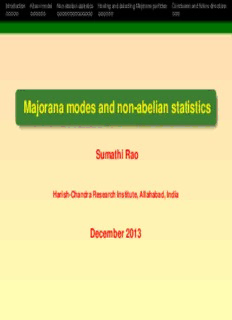
Majorana modes and non-abelian statistics - Harish-Chandra PDF
Preview Majorana modes and non-abelian statistics - Harish-Chandra
Introduction Kitaevmodel Non-abelianstatistics HostinganddetectingMajoranaparticles Conclusionandfuturedirections Majorana modes and non-abelian statistics Sumathi Rao Harish-ChandraResearchInstitute,Allahabad,India December 2013 Introduction Kitaevmodel Non-abelianstatistics HostinganddetectingMajoranaparticles Conclusionandfuturedirections Plan of the talk 1 Introduction 2 Kitaev model 3 Non-abelian statistics 4 Hosting and detecting Majorana particles 5 Conclusion and future directions Introduction Kitaevmodel Non-abelianstatistics HostinganddetectingMajoranaparticles Conclusionandfuturedirections Introduction Introduction Kitaevmodel Non-abelianstatistics HostinganddetectingMajoranaparticles Conclusionandfuturedirections What are Majorana fermions or Majorana modes? Named after Ettore Majorana But refer to different kinds of excitations in high energy physics and condensed matter physics Introduction Kitaevmodel Non-abelianstatistics HostinganddetectingMajoranaparticles Conclusionandfuturedirections Nomenclature In particle physics, Majorana fermions are fermionic particles ≡ anti-particles, ψ = ψ†, where ψ,ψ† are annihilation and creation operators In condensed matter physics, hermitian operators γ = γ† satisfying fermionic algebra {γ ,γ } = 2δ γ2 = 1, a b ab a form zero energy modes of some system. Not true fermions (sometimes called weird fermions!), but instead obey non-abelian statistics under exchange Introduction Kitaevmodel Non-abelianstatistics HostinganddetectingMajoranaparticles Conclusionandfuturedirections Pairs of Majorana fermions can be combined into ordinary fermions 1 1 c = (γ +iγ ),c† = (γ −iγ ), 1 2 1 2 2 2 form a single 2 level system If the Majorana fermions are spatially separated, implies fermion state is delocalised, Protected from local changes that affect only one of the Majorana fermions, hence protected from decoherence Expected to be relevant for topological quantum computation Introduction Kitaevmodel Non-abelianstatistics HostinganddetectingMajoranaparticles Conclusionandfuturedirections Majorana fermion expected to be equal superposition of particle and hole states S-wave superconductors have Boguliobov quasi-particles which are superpositions of spin up and down fermions b = uc†+vc ↑ ↓ But Majorana fermions γ = c +c†, 1 σ σ γ = −i(c −c†) 2 σ σ made up of superpositions of fermions with equal spin Need effectively spinless or p-wave superconductors Introduction Kitaevmodel Non-abelianstatistics HostinganddetectingMajoranaparticles Conclusionandfuturedirections Kitaev Model Introduction Kitaevmodel Non-abelianstatistics HostinganddetectingMajoranaparticles Conclusionandfuturedirections Kitaev Model Kitaev’s toy model for 1D spinless p wave superconductor: H = −µ(cid:88)c†c − 1 (cid:88)(tc†c +∆c c +h.c.) x x 2 x x+1 x x+1 x i ∆ ≥ 0 = p wave pairing amplitude Can rewrite in terms of Majorana fermions 1 c = (γ +iγ ), x x,1 x,2 2 1 c† = (γ −iγ ) x 2 x,1 x,2 Introduction Kitaevmodel Non-abelianstatistics HostinganddetectingMajoranaparticles Conclusionandfuturedirections The two limits LIMIT 1 : µ < 0,t = ∆ = 0 (Topologically trivial phase) N µ (cid:88) H = − (1+iγ γ ) B,x A,x 2 x=1 Here, fermion at single site is broken up into 2 Majoranas The ground state is unique and the ends of the chain do not play any major role
Description: